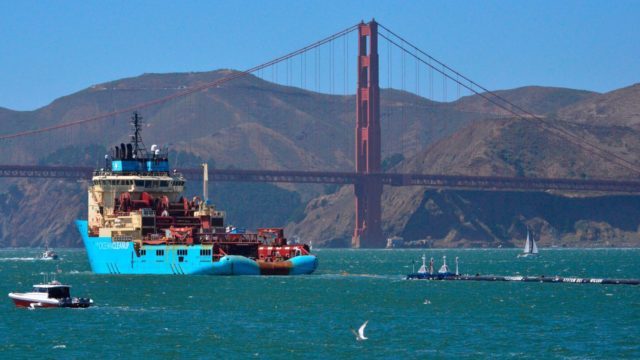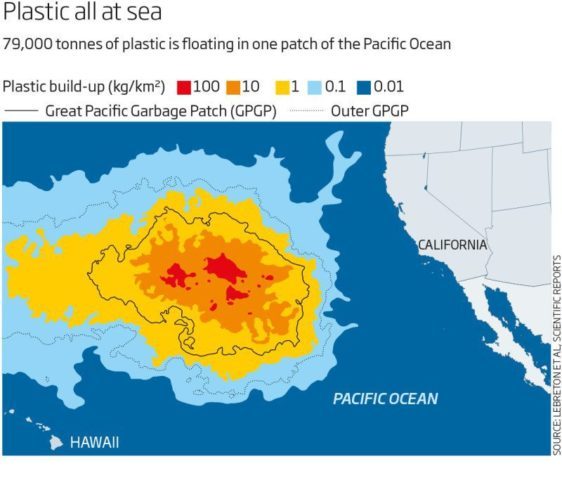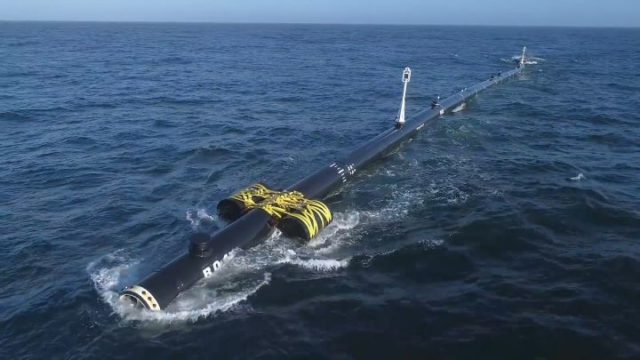During its deployment from San Francisco, it looked like a giant sea serpent. But it is a work of engineering designed to reduce in half to half the enormous oceanic plastic spillway called the “Great Pacific Garbage Patch“. The project, developed by the Dutch foundation “The Ocean Cleanup” for the last 5 years, is already in its operational phase.

The work consists of a barrier formed by a floating tube of 600 meters long, which will create a kind of “U” to trap the waste thanks to the push of wind and waves. A “Pac-man” of the seas, according to those who are responsible for the project. The plastic will be collected by boats and moved to the coast for recycling.
But part of the scientific community raises doubts about the effectiveness of the operation, which has cost more than 20 million dollars, and the possible risks to marine fauna. The tests, which began this Saturday before deploying the operation, will be essential to find out.
It all started in 2013 on the initiative of Boyan Stan, a Dutchman who was then 18 years old. This young man was shocked by the amount of waste that was when he was going to dive and went to work to find solutions to the problem, as shown on the website of The Ocean Cleanup. Stan wanted to create a viable method of concentration and collection of marine litter and launched the organization to develop new technologies. A little more than a year later, about a hundred volunteer scientists had joined the project and almost US$ 2.2 million of funding was collected with a Crowdfunding campaign.
Researchers attached to the initiative carried out various studies of the area affected by the plastic dump. A few months ago, the main results of his observations came out in Scientific Reports. The Great Pacific Garbage Patch has reached an area of 1.6 million square kilometers, according to estimates.
There, it is accumulated about 1.8 billion plastic waste, according to the foundation, with an approximate weight of 80,000 tons. “A significant percentage of plastics are trapped in eddies created by ocean currents”, explains The Ocean Cleanup. “Once stuck there, the plastic melts and becomes a trap for the marine fauna, deceived by the appearance of food”, he adds.

For the organization, trying to collect all that trash with boats and networks would be too expensive and would generate impactful emissions for the environment and damage to marine fauna. In the opinion of The Ocean Cleanup, a method of concentration of “passive” waste, which moves at the same time as currents, is more viable. This explains the idea of using a floating barrier, called System 001: it is a tube with a curtain 3 meters deep that allows capturing the plastic and, at the same time, leaves the passage to the fish below it.
The Ocean Cleanup has already launched the operational phase of its project. The tube was deployed with a ship from the port of San Francisco to an intermediate area with respect to the Great Pacific Garbage Patch, located 240 nautical miles from the coast. A 2-week test period is scheduled there to determine the effectiveness of the system. If everything goes as planned, the engineering work will be transferred directly to the landfill area.

The doubts of the scientists
There remain some doubts about the viability of this technology. Some oceanographers have expressed concern about the possibility that the system could harm marine animals. “In the superficial part of the sea there are all kinds of organisms”, says Jesús Gago of the Spanish Institute of Oceanography. “The presented scheme seems to be dragging everything. There may be that risk [of damage to the marine fauna]. With tests, then it comes the test of fire”, he adds.
The foundation explains that the tests will serve to clarify those critical aspects of the project on which prototypes and previous experiments have not been able to clear all doubts. Among them, the response of the system to movements caused by wind and currents, the ability to concentrate and retain the captured plastic and the resistance to disruptive elements of the ocean such as waves and corrosion caused by salt will be evaluated, he argues.
He also states that different organizations, such as the University of Miami and the National Oceanic and Atmospheric Administration, have offered advice to ensure that the floating barrier does not generate negative impacts for marine fauna.
Currently, they have begun testing to caliber the system, according to The Ocean Cleanup. The route can be monitored at any time on the foundation’s website, thanks to a GPS tracking system installed on the tube. The Great Pacific Garbage Patch is about 1,000 miles further. Engineers at The Ocean Cleanup have predicted that the new waste collection system will take 2 or 3 weeks to reach the landfill after the testing period.
The following phases of the project foresee that “every few months” a ship will approach the garbage dump and collect the concentrated waste. The Ocean Cleanup is studying ways to recycle all the recovered plastic and economically sustain the process of cleaning the waters with the sale of products collected from that material.
Gago believes that this mission will have its difficulties. “They are materials affected by sun exposure and seawater. I am not sure that this material can be used in a recycling plant in a simple way”, he says. The foundation plans to develop up to 60 systems similar to this one to be able to extend the cleaning operations also to another 4 oceanic plastic dumps.


